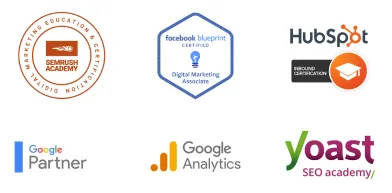TO LEARN IS TO GROW
Learning Center
We do our research and publish our results. Should probably call this the Growing Center.


9 Easy Steps to a Successful Website Redesign
Redesigning your website can be an exciting opportunity to improve its look, functionality, and performance. However, it can also be overwhelming, especially if you’re worried about losing traffic and disrupting your existing SEO efforts. That’s why we’ve put together these nine easy steps to help you achieve a successful website redesign.
From defining your goals and audience to creating a plan and testing your new design, these steps will guide you through the process and ensure you create a website that meets your needs and those of your visitors. So sit back, relax, and let’s get started on creating a website that truly stands out.

A Step-by-Step Guide to Redesigning Your Website
1. Assess Your Current Website
When it comes to redesigning your website, taking a step back to evaluate your current design and functionality can be the perfect starting point. Not only will this give you a better understanding of what needs to be improved, but it can also help you retain your existing traffic while upgrading your site.
Take a good look at your website’s layout, color scheme, typography, and overall aesthetic. Ask yourself if it looks modern and visually appealing and whether or not it aligns with your brand identity. Consider the user experience as well; is it easy to navigate, and do pages load quickly? Don’t hesitate to make a list of any design elements that need improvement, and keep them in mind as you move forward.
Analyze your website’s functionality. Make sure your website is responsive and functions properly on different devices. Check for any broken links, missing images, or other technical issues that need to be addressed. Pay attention to how users interact with your site, and if it’s not already optimized for search engines, consider working with a professional to make that happen.
Take a closer look at your website’s performance and traffic sources. This will give you insights into your current audience and how they engage with your website. Utilize tools like Google Analytics to gather data on your website’s traffic sources, bounce rate, and user behavior. The information you gather can help you identify areas for improvement, such as optimizing landing pages and improving user engagement.

2. Set Goals for Your Redesign
When redesigning your website, it’s essential to have clear goals in mind. Defining your objectives can help you develop a strategy to meet them and establish a plan that measures the performance of your revamped website. In this way, you can ensure that the changes you make align with your business goals and deliver the desired results.
Determine what you want to achieve with your website redesign. Depending on the current state of your website’s design and functionality, this could involve reskinning, redevelopment, or restructuring.
Reskinning is the way to go if you find that your website’s design looks outdated or doesn’t reflect your brand’s current image. This approach involves updating the look and feel of your website without changing the underlying code or functionality.
Redevelopment, on the other hand, involves updating the code and functionality of your website. This is recommended if your website’s underlying structure is outdated or if you need to add new features to your website.
Restructuring will change the organization and navigation of your website. This is the ideal approach if your website’s current structure is confusing or doesn’t align with your target audience’s needs. It requires careful planning and attention to user experience to ensure that visitors can easily find what they’re looking for on your website.
Develop a strategy to meet those goals. This may involve updating your website’s design and functionality, optimizing your content for search engines, or improving the user experience of your website.
Outline a plan to measure the success of your redesign. Identify the metrics you’ll use to evaluate the success of your redesign, such as traffic, engagement, and conversion rates. Then, outline a plan to measure these metrics and track them over time.
3. Define Your Target Audience
Remember that your website is a reflection of your brand, and it should be designed to appeal to your target audience. By understanding your audience’s needs and preferences, you can create a website that is not only visually appealing but also engaging and user-friendly.
Identify your ideal customer. Start by identifying your target audience, including their demographics, interests, and behaviors. This will help you create a website that speaks directly to their needs.
Understand their needs and preferences. Conduct market research and gather feedback from your existing customers to gain insights into what they’re looking for from your website.
Develop a buyer’s persona to guide your redesign. A buyer’s persona is a fictional representation of your ideal customer based on real data and insights. By developing a buyer’s persona, you can create a more targeted and personalized website that resonates with your audience.
4. Create a Content Strategy
Creating engaging, relevant, and informative content is crucial to the success of your website redesign. By evaluating your current content and developing a plan to create new content, you can ensure that your website provides value to your audience.
Evaluate your current content. Take a close look at your existing content, such as web copies, blog posts, images, videos, and other media. Identify what’s working and what’s not, and use this information to inform your content strategy. Consider which topics your audience is most interested in and what type of content resonates with them.
Develop a plan to create new content. Next, you need to come up with a plan to create new content that aligns with your goals and the needs of your target audience. Consider what types of content will be most effective, such as blog posts, infographics, or video content, and develop a content calendar to ensure that you’re consistently producing high-quality content. This will not only help you stay organized but also ensure that your content is fresh and engaging for your audience.
Determine the most effective ways to present your content without losing traffic. This may involve optimizing your content for search engines, creating a user-friendly navigation structure, or making your content more visually appealing.
5. Choose a Design and Layout
Creating a visually appealing, user-friendly website is essential to retaining existing traffic and attracting new visitors. With a design and layout that perfectly reflects your brand and meets the needs of your target audience, you can create a website that engages and delights visitors.
Review current web design trends for 2023. Look into the latest web design trends for 2023, such as color schemes, typography, and layout. This will help you stay up to date with the latest design trends and create a website that looks modern and professional.
Choose a color scheme and typography. Next, you need to choose a color scheme and typography that reflects your brand and resonates with your target audience. Consider the emotions and associations that different colors and fonts can evoke, and choose those that align with your brand identity and message. For instance, if your brand is youthful and vibrant, you might choose bright and bold colors, while a more traditional brand might prefer a more muted color palette.
Determine the layout and structure of your new website. Consider how visitors will navigate your website, how you’ll organize your content, and how you’ll present your products or services. It’s important to make sure that your website’s structure is clear and easy to use so that visitors can quickly find what they’re looking for. Consider using a clear and concise navigation menu, adding visual cues such as icons, and ensuring that your content is easy to read and visually appealing.
6. Perform an SEO Audit
It’s important to ensure that your SEO strategy is aligned with your overall goals and tailored to the needs of your target audience. Remember – optimizing your website for search engines is an ongoing process that requires continuous effort and attention.
Analyze your website’s SEO performance. Conduct keyword research to identify the most relevant and high-traffic keywords for your business. Analyze your website’s on-page and off-page SEO factors, such as meta tags, title tags, and header tags, to ensure that they are optimized for search engines. Review your website’s analytics data to gain insights into how visitors are finding and engaging with your website. Use this information to identify areas for improvement.
Identify areas for improvement. Once you’ve analyzed your website’s SEO performance, you need to identify which areas need improvement. This could entail updating your website’s content and meta tags, improving your website’s loading speed, or addressing any technical SEO issues that may be affecting your website’s performance (like broken links or duplicate content).
Develop an SEO strategy to optimize your website. Take steps to optimize your content for search engines by employing the current best practices, such as building high-quality backlinks or using social media and other channels to drive traffic to your website.
7. Develop a Website Architecture
The design and functionality of your website should be guided by the needs and preferences of your target audience. By taking the time to plan the structure and organization of your website, you can ensure that visitors will easily find what they’re looking for and enjoy a positive user experience.
Plan the structure and organization of your website. Consider the different pages and sections that your website will include and how they will be organized and connected to each other. This will help you create a logical and coherent website structure that is easy for visitors to navigate.
Create a sitemap. Once you’ve planned the structure and organization of your website, create a sitemap that outlines the different pages and sections of your website, as well as their relationships to each other. This will help you visualize your website’s structure and ensure that all of your content is properly organized and accessible.
Determine the navigation and functionality of your website. Think about how visitors will move through your website and how you can make it as easy as possible for them to find what they’re looking for. Make sure that features like contact forms and search bars are easy to use and prominently displayed so that visitors can easily engage with your website and find what they’re looking for.
8. Build Your Website
It’s finally time to start building your website! After carefully planning and strategizing, it’s time to bring your vision to life and create a website that reflects your brand, engages visitors, and drives conversions. Building a website can be an exciting and rewarding process, but it’s important to approach it with a clear plan and a focus on your goals.
Choose a website builder or Content Management System (CMS). Consider factors such as ease of use, customization options, and integration with third-party tools and services. Popular website builders include Wix, Squarespace, and WordPress, while popular CMS options include Drupal and Joomla. Do your research and choose a platform that suits your needs.
Choose a hosting provider. When deciding on a hosting provider, keep in mind such factors like uptime, reliability, and customer support, as well as any technical requirements that your website may have. Make sure to choose a hosting provider that can handle the amount of traffic you expect to receive, and that provides adequate security and backup options.
Develop and publish your website while maintaining traffic. This may involve migrating your existing website to the new platform, testing your website’s functionality and performance, and optimizing your website’s content and code for search engines. Make sure that your website is mobile-friendly and optimized for fast loading speeds. Consider implementing tracking and analytics tools to monitor your website’s performance and make data-driven improvements.
9. Test and Launch Your Website
Launching your website is an exciting milestone, but it’s important to approach it with care and attention to detail. By testing and launching your website carefully and monitoring its performance after launch, you can ensure that your website is fully functional, user-friendly, and optimized for search engines.
Test your website for functionality and usability. Before launching your website, you need to test it thoroughly for functionality and usability. This means testing your website’s navigation, forms, and other features, as well as conducting user testing to ensure that your website is easy to use and engaging for your visitors. Make sure that your website works well on different devices and browsers and that all links and buttons work as intended.
Launch your website without losing traffic. Once you’ve tested your website and made any necessary adjustments, it’s time to launch your website. To avoid losing traffic during the transition, it’s important to set up redirects, notify your existing customers and followers of the change, and closely monitor your website’s performance after launch. Consider sending an email newsletter or social media announcement to let your audience know about your new website and any changes they can expect.
Monitor your website’s performance and make adjustments as needed. After launching your website, it’s important to monitor its performance and make adjustments as needed. This entails analyzing your website’s traffic, engagement, and conversion rates and making changes to your content, design, and functionality to improve performance and achieve your goals. Update your website regularly with fresh content and ensure that it remains optimized for search engines.

Don't Wait, Start Your Website Redesign Today
Redesigning your website is essential in today’s digital world to stay ahead of the competition. It’s not just about having an aesthetically pleasing website; it’s about creating a seamless user experience and optimizing your website for search engines. A well-executed website redesign can improve your online presence, drive traffic, and increase conversions.
However, redesigning your website can be a daunting task, especially if you’re concerned about losing traffic and disrupting your existing SEO efforts. That’s where LOJO Marketing comes in. With our expertise, we can redesign your website without losing traffic, optimize your content for search engines, and ensure that your website is fully functional and user-friendly.
So, if you’re ready to take your online presence to the next level and improve your business outcomes, don’t hesitate to reach out to us for a free consultation. We can help you develop a customized website redesign strategy that aligns with your goals, target audience, and budget.
Built for Growth. Backed by 25 Years of Trust.
For over two decades, LOJO has been a trusted partner to hundreds of businesses just like yours. Whether working directly with owners, managers, teams, or boards of directors, our goal remains the same: to be a reliable and results-driven asset to your business.
Over the years, we’ve carefully built a team of experts—each selected for their unique skills, strengths, and personalities. Our clients choose LOJO because they know we genuinely care about their success.
And after 25 years of helping businesses grow, we’re more committed than ever.


Built for Growth. Backed by 25 Years of Trust.
For over two decades, LOJO has been a trusted partner to hundreds of businesses just like yours. Whether working directly with owners, managers, teams, or boards of directors, our goal remains the same: to be a reliable and results-driven asset to your business.
Over the years, we’ve carefully built a team of experts—each selected for their unique skills, strengths, and personalities. Our clients choose LOJO because they know we genuinely care about their success.
And after 25 years of helping businesses grow, we’re more committed than ever.




Matthew Rogers, President
iProspect Check
After spending several months reviewing multiple proposals from several different companies we engaged LOJO to develop a new website that represents our company effectively. We worked initially with Stephen Platte who helped create the scope of the project. Stephen was knowledgeable and always followed up with me on time and as promised.
He "closed the deal" for LOJO with his professionalism, service orientation and easy going approach. Once we signed the contract we were introduced to Jay Kelly who would be the creative lead for LOJO. This was the most challenging part of the project for my company, as there was no shortage of ideas from our side. Jay managed the project flawlessly, and once we had all agreed to the design, Jay introduced us to Eric.
Eric Lay is one of the founders of LOJO. Eric took the design we had developed and brought it to life. We delivered content as quickly as he requested it. Eric kept the project on task and we responded by exceeding every deadline for content. In turn, once provided, literally not a day went by that Eric didn't add the content and take the next step. In just a few weeks we launched our new website. Eric is a pleasure to work with.
His positive attitude and consultative approach really enhanced the experience and made a big difference for us in the outcome of our project. We would welcome you to visit our website to take a look at the quality work of LOJO. We are very pleased with LOJO and look forward to working with them in the future as we pursue an aggressive SEO strategy."
After spending several months reviewing multiple proposals from several different companies we engaged LOJO to develop a new website that represents our company effectively. We worked initially with Stephen Platte who helped create the scope of the project. Stephen was knowledgeable and always followed up with me on time and as promised.
He "closed the deal" for LOJO with his professionalism, service orientation and easy going approach. Once we signed the contract we were introduced to Jay Kelly who would be the creative lead for LOJO. This was the most challenging part of the project for my company, as there was no shortage of ideas from our side. Jay managed the project flawlessly, and once we had all agreed to the design, Jay introduced us to Eric.
Eric Lay is one of the founders of LOJO. Eric took the design we had developed and brought it to life. We delivered content as quickly as he requested it. Eric kept the project on task and we responded by exceeding every deadline for content. In turn, once provided, literally not a day went by that Eric didn't add the content and take the next step. In just a few weeks we launched our new website. Eric is a pleasure to work with.
His positive attitude and consultative approach really enhanced the experience and made a big difference for us in the outcome of our project. We would welcome you to visit our website to take a look at the quality work of LOJO. We are very pleased with LOJO and look forward to working with them in the future as we pursue an aggressive SEO strategy."

Matthew Rogers, President
iProspect Check
The team at LOJO were wonderful to work with. They are well organized and very patient as we worked through our marketing strategy and developed a well thought out and clear action plan at a reasonable price. We will definitely be back for our future campaign needs."

Jon Crosby, Founder
Dazil

